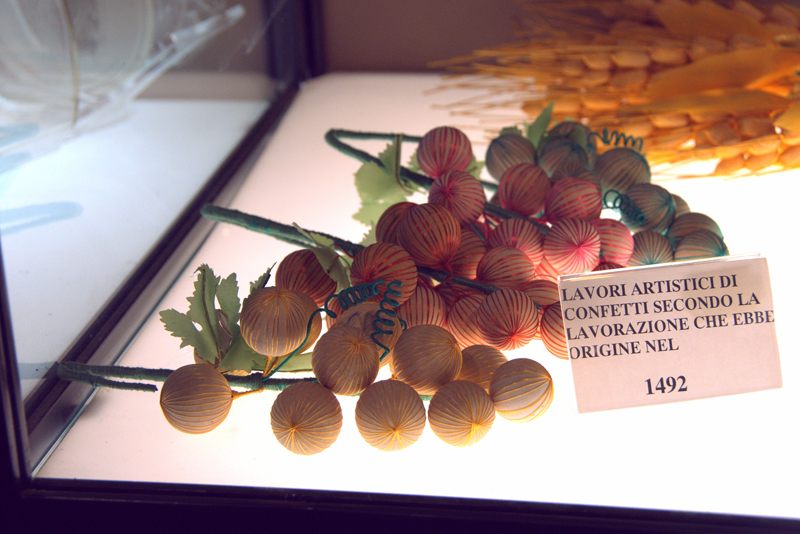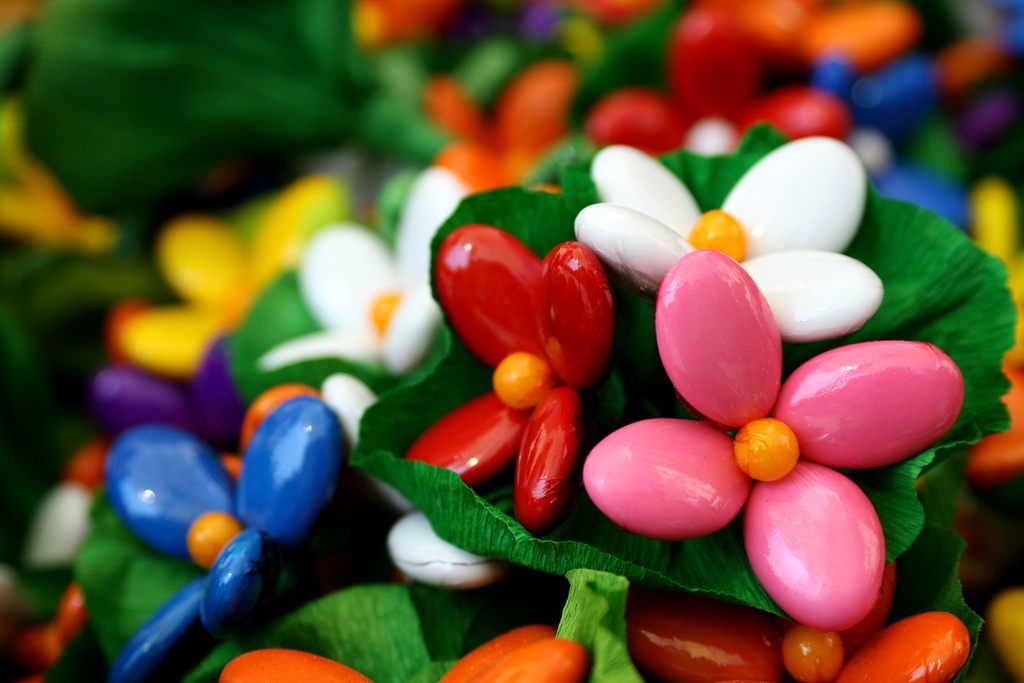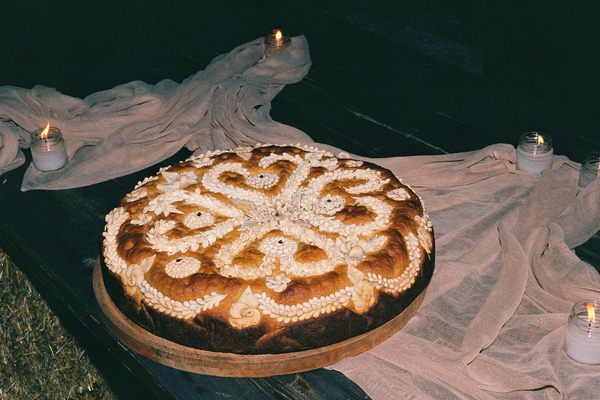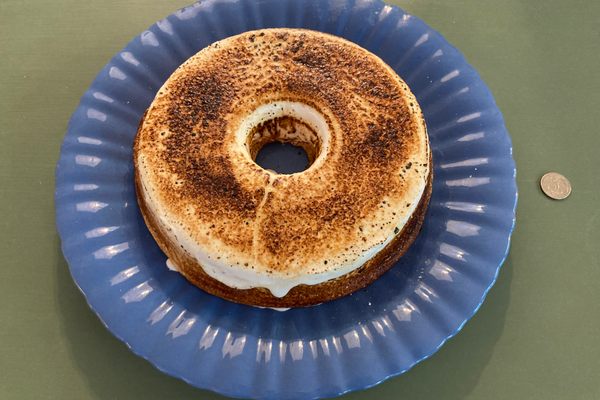Confetti Candy, the Ancient Italian Predecessor of the Tic Tac
People have been eating (and throwing) candy-coated almonds for two millennia.

Confetti candy made into flowers. (Photo: Ra Boe/CC BY-SA 2.5)

Wedding season in the Northern Hemisphere is already in full swing, which means a lot of guests will soon be going home with small net bags of tooth-breakingly hard candy-coated almonds, the wedding reception equivalent of candy corn. Some of the guests will joke about how they’re old-person candy and must have been sitting out for years to get so hard. And in fact they are old—one of the oldest confections in the world. Those candy almonds, confetti, are the Italian sweetmeat for which paper confetti is named—small, bright colored, and thrown like Mardi Gras beads at Renaissance parties.
The heart of Italian confetti manufacture is an ancient hill town named Sulmona, the birthplace of Ovid. It’s been a confetti center since the 1400s, but the availability of sugar limited production until the late 1700s, when the first modern confetti factories were born. Of the nine Sulmona candy factories currently operating, the oldest and most revered is Confetti Mario Pelino, which has been manufacturing confetti since 1783—five years before the U.S. Constitution was ratified.

The piazza in Sulmona. (Photo: Public Domain)
A trip through the Confetti Pelino museum is like a visit to Wonka’s Chocolate Factory, but less unpredictable. A visitor is first greeted by shelves full of colorful candy ornaments shaped like flowers, a Sulmona hallmark. At the first landing of an iron staircase, a thick window looks onto the factory floor, where dozens of copper barrels whirl next to flames and cooling jets as candy coatings are applied.
Further up the staircase are rooms full of old confetti-making machinery: a wooden hand-cranked almond huller from the 1930s; a shimmering glass ball used to apply edible silver foil in 1918; wide, flat-bottomed cauldrons suspended from the ceiling, in which fruits and seeds were hand-candied in the 17th and 18th centuries.

The factory floor. (Photo: Romie Stott)
The first reference to confetti appears in a cookbook called Apicus: De Re Coquinaria, compiled in the 5th century from recipes it claimed originated in the 1st, and describes nuts and fruits with a honey shell. By the time Boccaccio wrote his Decameron in the 14th century, the confection had acquired its current name, from the verb confettare, to sugar coat. Confetti show up in story three on day seven, in the middle of a rant about monks who preach abstinence but treat themselves to imported wines and boxes of candy.
Confetti ‘s role in contemporary Italian life has since become ritualistic: they’re an expected gift at births (in pink or blue hues), baptisms and first communions (white), graduations (red), engagements (green), and significant anniversaries, with specific color and presentation codes. The closest U.S. equivalent is the champagne toast: you can drink champagne as an everyday indulgence—or you can pop open a bottle to solemnize a special occasion.

Candy decorated as flowers for sale at the Confetti Pelino Museum. (Photo: Romie Stott)
Even for Americans, confetti are a bigger part of everyday life than most people realize: Tic Tacs are essentially confetti made to target the American palette, aniseed confetti with the aniseed removed. This was the genius idea of Nutella mogul Michele Ferrero, who needed a way to break into the U.S. market. Who could resist a tiny, bright candy that cheerfully clicked against its box? Tic Tacs’ success established a distribution network which allowed him to bring over not only Nutella, but Ferrero Rocher pralines and Kinder eggs. At the time of his death in 2015, he was the richest person in Italy, a billionaire twenty times over, thanks to a fortune built on the back of this ancient candy.
In the hierarchy of confetti, the most valued ingredient are almonds from Sicily, which are flatter, broader, and more floral-flavored than California varieties. They’re also much more expensive than chocolate, hazelnuts, candied fruit, or other types of almond, which is part of what gives them their status. As a result, the most prestigious confetti are those with the thinnest candy coatings, which allows them to be as soft as the high-quality almonds inside them. You can sometimes catch an Italian surreptitiously checking the likely expense of someone else’s celebratory confetti by taking one out of the dish and squeezing it.

Replica confetti from 1492. (Photo: Romie Stott)
However, a glance at the museum’s historic replicas makes it obvious this wasn’t always the test of value. In 1492, when sugar was unquestionably the most expensive ingredient, high-status confetti were spherical bonbons about half the diameter of a ping pong ball—jawbreakers with a small seed in the center. They were sometimes strung into giant rosaries, the 15th century version of candy-raver necklaces.
At Italian weddings, each guest will be sent home with an ornamental box called a bomboniere, filled with five confetti, or another odd number, to show the marriage is indivisible. (An even number is too easily split; even numbers are reserved for funeral flowers.) Meanwhile, a parent celebrating the birth of a child shares confetti at work instead of cigars, and it’s terribly rude to refuse one.

A close-up of the Sulmona confetti. (Photo: Irene Bonacchi/CC BY-ND 2.0)
Nevertheless, if you’re stuck at a wedding reception with candied almonds and you despise them—maybe they’re not from Sulmona, maybe somebody gave you an even number—you could always throw them. You’d be in good company; citywide confetti street brawls were so central to some Italian festivals that they spawned a cottage industry literary travelogues. In one of the earliest, Goethe’s description of the 1788 Roman carnival, he notes that parade goers reserved their expensive, heavy candy-coated almonds as missiles of last resort, instead flinging cheaper substitutes like chalk or plaster balls, or sugar-coated grains, to prolong the fun.
However, Charles Dickens’ 1846 travelogue suggests a greater enthusiasm for battle. He loads his carriage with a clothes hamper of candy plus two three-foot-tall sacks full of sugarplums, and then wisely dons a protective face mask. (Italians switched to throwing paper confetti shortly after 1875, when Enrico Mangili realized he could sell bags of the machine-cut paper circles that were a byproduct of manufacturing his primary commodity, silkworm bedding. Italians call the paper stuff coriandoli, after the coriander seeds which were sometimes used as a cheap substitute.)

An almond hulling machine from 1930. (Photo: Romie Stott)
Despite the well-documented fierceness of these pitched confetti battles—in some tellings, the wearing of masks during Carnevale became ubiquitous not out of a love of costume, but to reduce the chance of eye injury from aggressively-fired candy slingshots—there’s only one famous death attributed to confetti, and it came from overeating, or so the legend goes. Italian Enlightenment poet Giacomo Leopardi is said to have died after eating three pounds of Sulmona confetti in one sitting, even though he was diabetic. Supposedly, he was so bewitched by their enticing smell that he threw caution to the wind and went out in a blaze of cinnamon-flavored, canellini-bean-shaped glory.
It’s almost certain that this suicide-by-confetti was a lie invented by Leopardi’s friend Antonio Ranieri to cover up a case of cholera; the disease was raging in Italy at the time, and anti-epidemic laws then in-force would have prevented a church burial for anyone who died of the illness. To spare his friend a mass grave, Raineri needed a cover story. The fact that his lie was judged to be plausible, and is still repeated today (always with the specification that the confetti was from Sulmona) tells you something about the maniacal reverence Italians have for this candy. People wouldn’t believe that about just any sweet.
Ranieri was kind enough to donate Leopardi’s unfinished confetti to the Pelino museum, where they’re displayed in a sealed glass jar on a red satin perch. If after regarding their deadly, delicious beauty, you too are enraptured by their sugared siren call, the gift shop out front would be more than happy to sell you your own three pounds of candy. Whether you eat it or throw it is up to you.
Gastro Obscura covers the world’s most wondrous food and drink.
Sign up for our regular newsletter.
























Follow us on Twitter to get the latest on the world's hidden wonders.
Like us on Facebook to get the latest on the world's hidden wonders.
Follow us on Twitter Like us on Facebook